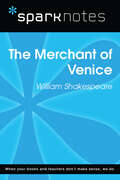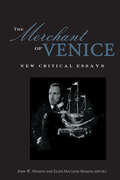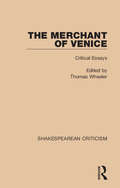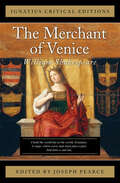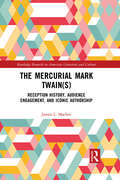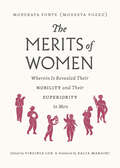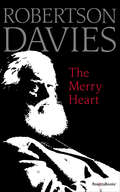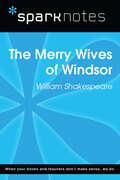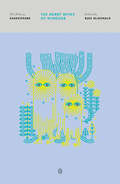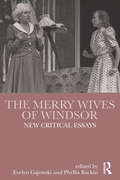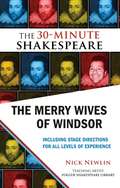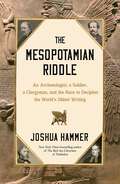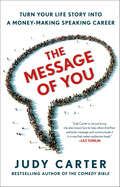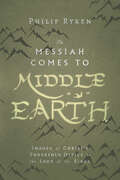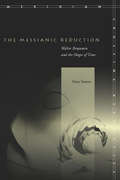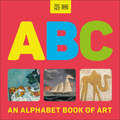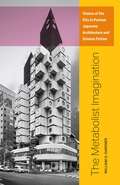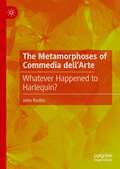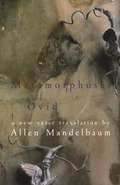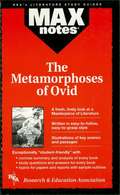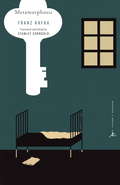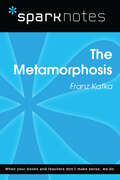- Table View
- List View
The Merchant of Venice (SparkNotes Literature Guide Series)
by SparkNotesThe Merchant of Venice (SparkNotes Literature Guide) by William Shakespeare Making the reading experience fun! Created by Harvard students for students everywhere, SparkNotes is a new breed of study guide: smarter, better, faster. Geared to what today's students need to know, SparkNotes provides: *Chapter-by-chapter analysis *Explanations of key themes, motifs, and symbols *A review quiz and essay topicsLively and accessible, these guides are perfect for late-night studying and writing papers
The Merchant of Venice (The New Cambridge Shakespeare)
by William Shakespeare M. M. MahoodCharles Edelman focuses on the play's sexual politics and recent scholarship devoted to the position of Jews in Shakespeare's time in this new edition. He surveys the international scope of theatrical interpretations of The Merchant in the 1980s and 1990s as well as different ways of tackling the troubling figure of Shylock. First Edition Hb (1988): 0-521-22156-0 First Edition Pb (1988): 0-521-29371-5
The Merchant of Venice: Critical Essays (Shakespeare Criticism #26)
by John W. Mahon Ellen Macleod MahonThis volume is a collection of all-new original essays covering everything from feminist to postcolonial readings of the play as well as source queries and analyses of historical performances of the play. The Merchant of Venice is a collection of seventeen new essays that explore the concepts of anti-Semitism, the work of Christopher Marlowe, the politics of commerce and making the play palatable to a modern audience. The characters, Portia and Shylock, are examined in fascinating detail. With in-depth analyses of the text, the play in performance and individual characters, this book promises to be the essential resource on the play for all Shakespeare enthusiasts.
The Merchant of Venice: Critical Essays (Shakespearean Criticism)
by Thomas WheelerOriginally published in 1991. Essays here are arranged chronologically within sections: ‘The Play as Text’, ‘Shylock’ and ‘The Play in the Theatre.’ Collecting previously published important commentaries and scholarly articles, this volume in the Shakespearean Criticism set looks at one of the Bard’s most disturbing plays. These historical critical pieces give witness to the changing attitudes to the play and the characters and provide readers with a wide range of material relating both to performances and to textual readings.
The Merchant of Venice: With Contemporary Criticism (Ignatius Critical Editions)
by William ShakespeareThe Merchant of Venice is probably the most controversial of all Shakespeare's plays. It is also one of the least understood. Is it a comedy or a tragedy? What is the meaning behind the test of the caskets? Who is the real villain of the trial scene? Is Shylock simply vicious and venomous, or is he more sinned against than sinning? Can the play be described as anti-semitic? What exactly is the quality of mercy? Is Portia one of the great Christian heroines of western literature? And what of the comedy of the rings with which Shakespeare ends the play? These questions and many others are answered in this critical edition of one of the Bard's liveliest plays.
The Mercurial Mark Twain: Reception History and Iconic Authorship (Routledge Research in American Literature and Culture)
by James L. MachorWho was Mark Twain? Was he the genial author of two beloved boys books, the white-haired and white-suited avuncular humorist, the realistic novelist, the exposer of shams, the author repressed by bourgeois values, or the social satirist whose later writings embody an increasingly dark view? In light of those and other conceptions, the question we need to ask is not who he was but how did we get so many Mark Twains? The Mercurial Mark Twains(s): Reception History and Iconic Authorship provides answers to that question by examining the way Twain, his texts, and his image have been constructed by his audiences. Drawing on archival records of responses from common readers, reviewer reactions, analyses by Twain scholars and critics, and film and television adaptations, this study provides the first wide-ranging, fine-grained historical analysis of Twain’s reception in both the public and private spheres, from the 1860s until the end of the twentieth century.
The Merge Hypothesis: A Theory of Aspects of Syntax
by Norbert HornsteinThe Merge Hypothesis is the central empirical theoretical contribution of the Minimalist Program (MP) to syntactic theory. This book offers an accessible overview of the MP, debunking common sixty years of Generative research, culminating in GB theory. He introduces The Fundamental Principle of Grammar, which advocates including labels as part of the Merge Operation and centring the notion of the constituent as the key domain of syntactic commerce. The early chapters identify the goals of the MP, how they arose from earlier descriptive and explanatory successes of the mentalist tradition within Generative Grammar, and how to develop them in future work to expand its descriptive and explanatory range. It is essential reading for anyone interested in contemporary syntactic theory.
The Merits of Women: Wherein Is Revealed Their Nobility and Their Superiority to Men
by Moderata Fonte“Among the great classics of early feminist thought . . . challenging, witty . . . a sometimes startlingly original discussion of women’s status.” —Literary HubYou would as well look for blood in a corpse as for the least shred of decency in a man . . .Without help from their wives, men are just like unlit lamps . . .Just think of them as an unreliable clock that tells you it’s ten o’clock when it’s in fact barely two . . .These are but a small selection of the quips bandied about at this lively gathering of women. Yet this dialogue unfolds not among ironically misandrist millennials venting at their local dive bar, but rather among sixteenth-century women—variously married, widowed, single, and betrothed—attending a respectable Venice garden party. Written in the early 1590s by Moderata Fonte, pseudonym of the Renaissance poet and writer Modesta Pozzo, this literary dialogue interrogates men and men’s treatment of women, and explores by contrast the virtues of singledom and female friendship.A new introduction by translator Virginia Cox and foreword by Dacia Maraini situate The Merits of Women in its historical context, written as it was on the cusp of Shakespeare’s heyday, and straddling the centuries between the feminist works of Christine de Pizan and Mary Wollstonecraft. Elegantly presented for a general audience, this is a must-read for baby feminists and “nasty women” alike, not to mention the perfect subtle gift for any mansplaining friend who needs a refresher on the merits of women . . . and their superiority to men.
The Merry Heart: Reflections on Reading, Writing, and the World of Books
by Robertson Davies&“A splendid gallimaufry of the eminent Canadian&’s talks and essays, mostly about literature and the creative life . . . a thought-filled and amusing book.&”—The Washington Post For devotees of Davies and all lovers of literature and language, here is the &“urbanity, wit, and high seriousness mixed by a master chef,&” vintage delights from an exquisite literary menu (Cleveland Plain Dealer). Robertson Davies&’s rich and varied collection of writings on the world of books and the miracle of language captures his inimitable voice and sustains his presence among us. Coming almost entirely from Davies&’s own files of unpublished material, these twenty-four essays and lectures range over themes from &“The Novelist and Magic&” to &“Literature and Technology,&” from &“Painting, Fiction, and Faking,&” to &“Can a Doctor Be a Humanist?&” and &“Creativity in Old Age.&” Davies himself says merely: &“Lucky writers . . . like wine, die rich in fruitiness and delicious aftertaste, so that their works survive them.&” &“Splendid—wise, witty, wide-ranging.&”—The New York Times Book Review &“Some of Davies&’s ideas are iconoclastic, and will delight those who share them while stimulating those who do not. All his judgments are interesting, steeped in humanism, and most elegantly put.&”—The Atlantic Monthly &“The inimitable novelist gives an exuberant posthumous performance in this eclectic collection of (mostly) previously unpublished addresses, talks, and incidental pieces . . . Davies diffuses his opinions entertainingly, if occasionally superficially, but never loses his audience.&”—Kirkus Reviews
The Merry Wives of Windsor (SparkNotes Literature Guide Series)
by SparkNotesThe Merry Wives of Windsor (SparkNotes Literature Guide) by William Shakespeare Making the reading experience fun! Created by Harvard students for students everywhere, SparkNotes is a new breed of study guide: smarter, better, faster. Geared to what today's students need to know, SparkNotes provides: *Chapter-by-chapter analysis *Explanations of key themes, motifs, and symbols *A review quiz and essay topicsLively and accessible, these guides are perfect for late-night studying and writing papers
The Merry Wives of Windsor (The Pelican Shakespeare)
by William Shakespeare Russ Mcdonald Stephen Orgel A. R. BraunmullerThe acclaimed Pelican Shakespeare series edited by A. R. Braunmuller and Stephen Orgel The legendary Pelican Shakespeare series features authoritative and meticulously researched texts paired with scholarship by renowned Shakespeareans. Each book includes an essay on the theatrical world of Shakespeare’s time, an introduction to the individual play, and a detailed note on the text used. Updated by general editors Stephen Orgel and A. R. Braunmuller, these easy-to-read editions incorporate over thirty years of Shakespeare scholarship undertaken since the original series, edited by Alfred Harbage, appeared between 1956 and 1967. With definitive texts and illuminating essays, the Pelican Shakespeare will remain a valued resource for students, teachers, and theater professionals for many years to come. For more than seventy years, Penguin has been the leading publisher of classic literature in the English-speaking world. With more than 1,700 titles, Penguin Classics represents a global bookshelf of the best works throughout history and across genres and disciplines. Readers trust the series to provide authoritative texts enhanced by introductions and notes by distinguished scholars and contemporary authors, as well as up-to-date translations by award-winning translators.
The Merry Wives of Windsor: New Critical Essays (Shakespeare Criticism)
by Phyllis Rackin Evelyn GajowskiThe Merry Wives of Windsor has recently experienced a resurgence of critical interest. At times considered one of Shakespeare’s weaker plays, it is often dismissed or marginalized; however, developments in feminist, ecocritical and new historicist criticism have opened up new perspectives and this collection of 18 essays by top Shakespeare scholars sheds fresh light on the play. The detailed introduction by Phyllis Rackin and Evelyn Gajowski provides a historical survey of the play and ties into an evolving critical and cultural context. The book’s sections look in turn at female community/female agency; theatrical alternatives; social and theatrical contexts; desire/sexuality; nature and performance to provide a contemporary critical analysis of the play.
The Merry Wives of Windsor: The 30-Minute Shakespeare
by Nick NewlinPlanning a school or amateur Shakespeare production? The best way to experience the plays is to perform them, but getting started can be a challenge: The complete plays are too long and complex, while scene selections or simplified language are too limited."The 30-Minute Shakespeare" is a new series of abridgements that tell the "story" of each play from start to finish while keeping the beauty of Shakespeare's language intact. Specific stage directions and character suggestions give even inexperienced actors the tools to perform Shakespeare with confidence, understanding, and fun!This cutting of THE MERRY WIVES OF WINDSOR begins with one of Shakespeare's favorite fat knights, Sir John Falstaff, announcing his intention to woo both Mistress Ford and Mistress Page simultaneously, to the delight of his cohorts Bardolph, Pistol, and Nym, who then decide to double-cross Falstaff. The characters' movements on stage are clearly denoted so that even inexperienced actors can give the scenes life: Robin is nearsighted, Bardolph is a drunk who tries to juggle, and Pistol and Nym are constantly jostling for position. Other key moments include the hilarious wooing of Mistress Ford by Falstaff and the hysterical concealment of Falstaff in the laundry basket. The cutting ends in the woods with Falstaff dressed as a stag, being tormented by fairies for his comeuppance.The edition also includes an essay by editor Nick Newlin on how to produce a Shakespeare play with novice actors, and notes about the original production of this abridgement at the Folger Shakespeare Library's annual Student Shakespeare Festival.
The Mesopotamian Riddle: An Archaeologist, a Soldier, a Clergyman, and the Race to Decipher the World's Oldest Writing
by Joshua HammerA rollicking adventure starring three free-spirited Victorians on a twenty-year quest to decipher cuneiform, the oldest writing in the world—from the New York Times bestselling author of The Bad-Ass Librarians of Timbuktu.It was one of history&’s great vanishing acts. Around 3,400 BCE—as humans were gathering in complex urban settlements—a scribe in the mud-walled city-state of Uruk picked up a reed stylus to press tiny symbols into clay. For three millennia, wedge shape cuneiform script would record the military conquests, scientific discoveries, and epic literature of the great Mesopotamian kingdoms of Sumer, Assyria, and Babylon and of Persia&’s mighty Achaemenid Empire, along with precious minutiae about everyday life in the cradle of civilization. And then…the meaning of the characters was lost. London, 1857. In an era obsessed with human progress, mysterious palaces emerging from the desert sands had captured the Victorian public&’s imagination. Yet Europe&’s best philologists struggled to decipher the bizarre inscriptions excavators were digging up. Enter a swashbuckling archaeologist, a suave British military officer turned diplomat, and a cloistered Irish rector, all vying for glory in a race to decipher this script that would enable them to peek farther back into human history than ever before. From the ruins of Persepolis to lawless outposts of the crumbling Ottoman Empire, The Mesopotamian Riddle whisks you on a wild adventure through the golden age of archaeology in an epic quest to understand our past.
The Message of You: Turn Your Life Story into a Money-Making Speaking Career
by Judy CarterA step-by-step handbook that teaches readers to find the extraordinary stories tucked deep within them to make a difference in the lives of others—and to get paid—as a motivational speakerTHE MESSAGE OF YOU begins with a simple belief - that your greatest speech already exists and that it has already been delivered in front of a live audience masterfully and powerfully by you. Best-selling author and international comic, Judy Carter sets out to prove that THE MESSAGE OF YOU is in the advice you give to your friends; in the lessons you teach your children; in the stories you tell your family. It's expressed through the volunteer work you do, the way you run your business, the way you turned your messes into successes. THE MESSAGE OF YOU is a distillation of all of your experiences, both personal and professional, that form the narrative meaning of your life. A meaning that you can develop into a well-written, funny speech to inspire audiences, enhance your current profession, and launch a successful money making career as a professional speaker. In Part One of the book, Judy leads you through a series of in-depth exercises meant to mine your personal and professional experiences for stories that establish your qualifications, your problem/solutions, your action steps and your methodology. In Part Two, Judy has created a six-step structure for writing an entertaining and informative speech, guiding you through each step in detail. But the real bonus of THE MESSAGE OF YOU is that Judy is a comic. Her "Comedy Pass" chapter takes you through simple but effective comedy writing techniques that will transform even a flat PowerPoint snoozer into a knee-slapping showstopper of a keynote. Once your speech is well-written and funny, Judy takes you through Part Three, teaching you how to take your message to the masses with inexpensive but essential marketing tips. The Message of You offers an accessible approach, big picture guidance, and nitty-gritty nuts and bolts of sound advice. Judy has been a comedy and speaking coach for over twenty years. She's a firm believer that how you present your ideas is just as important as the ideas themselves. She knows that humor and strong content are the missing ingredients in most speeches and her book, THE MESSAGE OF YOU helps you discover both your message and your comedic voice by taking you through the same process she uses to coach her private clients.
The Messiah Comes to Middle-Earth: Images of Christ's Threefold Office in The Lord of the Rings (Hansen Lectureship Ser.)
by Philip RykenHow can we grasp the significance of what Jesus Christ did for us? Might literature help us as we seek to understand the Christian faith?J.R.R. Tolkien’s The Lord of the Rings has generated much discussion about the relationship between Christianity and literature. It is well known that Tolkien disliked allegory. Yet he acknowledged that his work is imbued with Christian symbolism and meaning.Based on the inaugural Hansen Lectureship series delivered at the Marion E. Wade Center by Philip Ryken, this volume mines the riches of Tolkien’s theological imagination. In the characters of Gandalf, Frodo, and Aragorn, Ryken hears echoes of the threefold office of Christ—his prophetic, priestly, and royal roles. Guided by Ryken, readers will discover that they can learn much about the one who is the true prophet, priest, and king through Tolkien's imaginative storytelling.
The Messianic Reduction: Walter Benjamin and the Shape of Time
by Peter FenvesThe Messianic Reduction is a groundbreaking study of Walter Benjamin's thought. Fenves places Benjamin's early writings in the context of contemporaneous philosophy, with particular attention to the work of Bergson, Cohen, Husserl, Frege, and Heidegger. By concentrating on a neglected dimension of Benjamin's friendship with Gershom Scholem, who was a student of mathematics before he became a scholar of Jewish mysticism, Fenves shows how mathematical research informs Benjamin's reflections on the problem of historical time. In order to capture the character of Benjamin's "entrance" into the phenomenological school, the book includes a thorough analysis of two early texts he wrote under the title of "The Rainbow," translated here for the first time. In its final chapters, the book works out Benjamin's deep and abiding engagement with Kantian critique, including Benjamin's discovery of the political counterpart to the categorical imperative in the idea of "pure violence."
The Met ABC: An Alphabet Book of Art (DK The Met)
by DKDiscover your ABCs at the museum! Little ones can learn the alphabet through artI went to the museum and I saw…Featuring artists from Gustav Klimt to Vincent van Gogh, young readers can learn the alphabet while discovering some of the world&’s most well-known paintings and intricate textiles. Developed in collaboration with The Metropolitan Museum of Art, The Met ABC is guaranteed to spark a lifelong love of learning and art appreciation. Each page features a famous artwork from The Metropolitan Museum of Art&’s collection, a letter, and a headword. A memory game at the end of the book reinforces learning. Children can discover apples with Cézanne, dance lessons with Degas, and waves with Hokusai. It&’s the baby art book series that grown-ups will love, too.
The Metabolist Imagination: Visions of the City in Postwar Japanese Architecture and Science Fiction
by William O. GardnerJapan&’s postwar urban imagination through the Metabolism architecture movement and visionary science fiction authors The devastation of the Second World War gave rise to imaginations both utopian and apocalyptic. In Japan, a fascinating confluence of architects and science fiction writers took advantage of this space to begin remaking urban design. In The Metabolist Imagination, William O. Gardner explores the unique Metabolism movement, which allied with science fiction authors to foresee the global cities that would emerge in the postwar era.This first comparative study of postwar Japanese architecture and science fiction builds on the resurgence of interest in Metabolist architecture while establishing new directions for exploration. Gardner focuses on how these innovators created unique versions of shared concepts—including futurity, megastructures, capsules, and cybercities—making lasting contributions that resonate with contemporary conversations around cyberpunk, climate change, anime, and more.The Metabolist Imagination features original documentation of collaborations between giants of postwar Japanese art and architecture, such as the landmark 1970 Osaka Expo. It also provides the most sustained English-language discussion to date of the work of Komatsu Sakyō, considered one of the &“big three&” authors of postwar Japanese science fiction. These studies are underscored by Gardner&’s insightful approach—treating architecture as a form of speculative fiction while positioning science fiction as an intervention into urban design—making it a necessary read for today&’s visionaries.
The Metamorphoses of Commedia dell’Arte: Whatever Happened to Harlequin?
by John RudlinThe Metamorphoses of Commedia dell’Arte traces the steps by which Commedia has been transformed by cultural contact outside Italy into popular forms which bear little resemblance to the original. The book follows the Masks of Arlecchino, Pedrolino and Pulcinella as they gradually migrate and mutate into Harlequin, Mr. Punch and seaside Pierrot troupes. What happened to Pantalone, Scaramouche, Colombina and the male Lover is also investigated, though they had no final forms of their own. This study constitutes a history of what happened, notably in France and Great Britain, to a supremely popular theatrical genre as a result of changing fashions in entertainment brought on by societal developments, civil and industrial revolution and dynastic change. It investigates how the genre was exploited by management, and even its own stars, lost its vitality and gradually ended up in ‘sunken’ forms.
The Metamorphoses of Ovid
by Allen MandelbaumThrough Mandelbaum’s poetic artistry, this gloriously entertaining achievement of literature-classical myths filtered through the worldly and far from reverent sensibility of the Roman poet Ovid-is revealed anew. “[An] extraordinary translation...brilliant” (Booklist). With an Introduction by the Translator.
The Metamorphoses of Ovid (MAXNotes Literature Guides)
by Dalma BrunauerREA's MAXnotes for Ovid's The Metamorphoses of Ovid MAXnotes offer a fresh look at masterpieces of literature, presented in a lively and interesting fashion. Written by literary experts who currently teach the subject, MAXnotes will enhance your understanding and enjoyment of the work. MAXnotes are designed to stimulate independent thought about the literary work by raising various issues and thought-provoking ideas and questions. MAXnotes cover the essentials of what one should know about each work, including an overall summary, character lists, an explanation and discussion of the plot, the work's historical context, illustrations to convey the mood of the work, and a biography of the author. Each chapter is individually summarized and analyzed, and has study questions and answers.
The Metamorphosis
by Franz Kafka Stanley CorngoldThe Metamorphosis is the story of a young man who, transformed overnight into a giant beetlelike insect, becomes an object of disgrace to his family, an outsider in his own home, a quintessentially alienated man. [This text is listed as an example that meets Common Core Standards in English language arts in grades 9-10 at http://www.corestandards.org.]
The Metamorphosis (SparkNotes Literature Guide Series)
by Franz Kafka SparkNotesLiterature GuidesCreated by Harvard students for students everywhere, SparkNotes is a new breed of study guide: smarter, better, faster. Geared to what todays students need to know, SparkNotes provides: *Chapter-by-chapter analysis*Explanations of key themes, motifs, and symbols*A review quiz and essay topicsLively and accessible, these guides are perfect for late-night studying and writing papers
The Metanarrative Of Blindness: A Re-reading Of Twentieth-century Anglophone Writing
by David Bolt<P>Although the theme of blindness occurs frequently in literature, literary criticism has rarely engaged the experiential knowledge of people with visual impairments. The Metanarrative of Blindness counters this trend by bringing to readings of twentieth-century works in English a perspective appreciative of impairment and disability. Author David Bolt examines representations of blindness in more than forty literary works, including writing by Kipling, Joyce, Synge, Orwell, H. G. Wells, Susan Sontag, and Stephen King, shedding light on the deficiencies of these representations and sometimes revealing an uncomfortable resonance with the Anglo-American science of eugenics. <P>What connects these seemingly disparate works is what Bolt calls “the metanarrative of blindness,” a narrative steeped in mythology and with deep roots in Western culture. Bolt examines literary representations of blindness using the analytical tools of disability studies in both the humanities and social sciences. His readings are also broadly appreciative of personal, social, and cultural aspects of disability, with the aim of bringing literary scholars to the growing discipline of disability studies, and vice versa. This interdisciplinary monograph is relevant to people working in literary studies, disability studies, psychology, sociology, applied linguistics, life writing, and cultural studies, as well as those with a general interest in education and representations of blindness.
